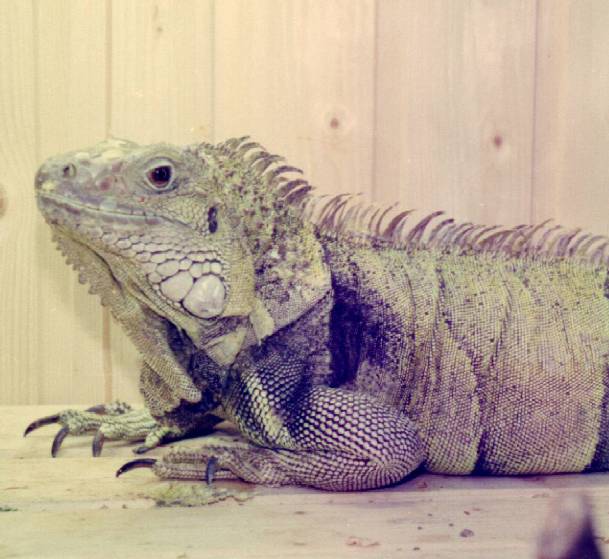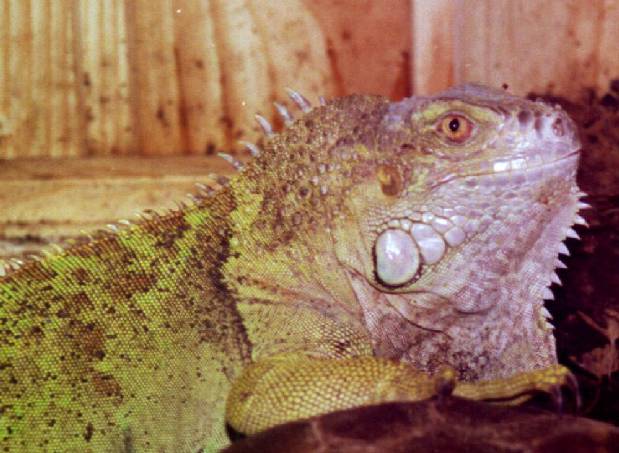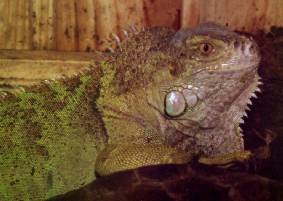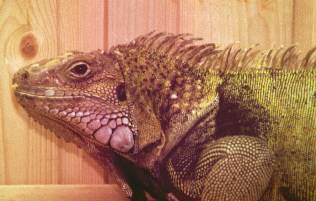
Green Iguana, Iguana iguana. You see the nominateform, Iguana i. iguana for here. She
doesn't have any hump shacks over the nostrils. The males of the nominateform are
drawn predominantly green or gray green. The females are like the males in the
coloring. The picture shows a 6 years old male. What does one recognize the male to?
Nape of the neck thorns and back thorns are equally long. At this the thorns
stand so thick with the males at each other that they almost touch himself. This
can already be recognized with young animals, too. In reptile books stands often
written that the dandruffs of the throat are than with females greater with
males. This isn't true with adult animals. In the reptile books stands written
also that the Femuralpores are than with the females greater with the males? The
Femuralpores with the males enlarge only in the courtship display time and then
also only temporarily. The photo of a female here now. The nape of the neck thorns are longer than the back thorns. The distance of
the thorns to each other is fundamentally safer than with the males. This animal
is 3 years old. It is part of the subspecies rinolopha. Between the nostrils two
are to three little hump shacks, this subspecies can be recognized at which .
the females often show an intensive blue green color. The primary color of the
males is brown red to brick colors.



return to Lizardpage Startpage
Here once again opposite female and male. The difference can be seen. Now to the food. The Green Iguana is a herbivore. This is called: His metabolism is coordinated
with the way of life in trees. He eats of this which he finds on the tree. These
are mainly leaves. Such herbivores under the reptiles (under all reptiles) react
to a too high share in animal protein in the food with kidney malfunctions or
till the duration with kidney failure. In this case the urine acid (the white
share in the excrement) can be eliminated no longer completely. This leads to
arthritises with swellings of the joints in the first phase. Skin sores appear
in the second phase. The animals die last. Herbivores nevertheless also need animal protein. There are protein
constituents which only can be produced by unicellular organisms, bacteria and
yeasts. This but for all vertebrates essential. The Lysin and the Methionin are
part of this. The l- Carnitin, this form both connected with each other for the
muscle construction and the detoxication function of the liver is indispensable. What now? Consider that in the free nature a tree resident robs once a bird's
nest, an insect catches or with pests, at the leaves of animal food to himself
takes from time to time, too. However, this always will be only a small portion
of the food. Leguane very much like to eat little animals. However, this may
never encourage us to feed our Leguane with too much dose food, flour worms or
mouse babies. Be valid here: The right dosage is the means of the choice. 1. The main food must be of vegetable origin. 2. Animal food is important. However, it shall are 5% with young animals and
pregnant females. Being supposed to be 1% of the complete food crowd animal food
with adult animals. A broader problem: It is praiseworthy to feed the efforts, our animals
closely to nature. However, it is impossible. Was close to nature be able to the
diet with leaves of fruit-trees, lime, birches, mountain ash, rowan-trees etc.
Of these food means be in the best case con-only con-food. We give Taraxacum,
cabbage, salad, berries stone and malaceous fruit bananas and citrus fruits to
this. Particularly the fruits have an unfavorable ratio of calcium to the
phosphorus, however. It is 1:3 to 1:5 lies here. However, the favorable
relationship is 5 parts calcium to 1 part phosphorus. The minimum
is 1.5: 1. Well, you see that we
don't get by without a well together mixed food. My experiences have kan let himself be seen, that be a basis for a long life
(particularly also for tortoises) a well balanced bottom food all herbivorous
reptiles. But ask: Such a bottom food is very nutritious and mustn't be given in
too great crowds. The animals become adiposis or else. Basic foot: (details in space parts) You mixes for 5 parts grain flaces
and vegetable flaces* 5 parts vegetables and fruits** and 1 part of limestone***
for bottom food: . Give 1 x on the day to the animals got so much till they are
replete. The rests should be removed fast. Mould is fatal for vertebrates. * These flakes must be free of animal components. I prefer ALLCO corn-flakes
(of Allco home animal from 27321 of Morsum-Wulmstorf, Germany). This food is free of
animal protein, preservation means and artificial pigments. Vitamin is in small
crowds leant on vitamine D3 and A. The flakes should 10minutes be soaked in a
sculpture sieve into waters approx. Then drip 10 minutes and are then used. ** I use apples, pear, to small pieces reduced for carrot, pumpkin,
cauliflower, zucchini, banana to this (depending on year offer). The size of the
pieces is dependent on the size of the animals. *** I must tell to the lime stone that I have around tried very long.
Preparations for reptiles are very expensive and contain much too much vitamin
D3 . Vitamin D3 is very harmfully in too high doses. In addition, many reptiles
don't eat food with very fine lime flour. Granulated natural lime stone is the
best. They will the correct size for the grains have taken by many animals well
if. I prefer Kalkgrit (lime stone) for (Dr. Ponsold GmbH 39387 Oschersleben, Germany).
This lime stone small pieces has the correct grain size (1-3 mm) for Leguane and
tortoises and is even taken by hatched tortoises and leguans. Animal protein: Adult animals get a part for animal protein into the bottom
food one times mixed per week. Young animals and pregnant females get this two
times per week. I use cat food for this, low-fat curd cheese or prawn wholemeal
alternately. As con-food should leaves are permanently available. Astonishing, which one
are sets of this one of Green Leguan for devour so daily into himself. At
this the change is very important. My animals very much like to eat food and
curly kale as well as horseradish leaves. You often warn in the literature in
front of the saponines contained in these plants and mustard oils. If you don't
give too much, these plants are a good natural remedy. You impede the growth of
non-physiology of (harmful) intestines residents and for this promote the
unicellular organisms, yeasts and bacteria which are essential for the digestion
and the formation of vitamins of the B complex. Still a word to the light. All reptiles which sunbathe under natural
conditions need absolutely ultraviolet light (UV) to the digestion, to the
well-being and to the regulation of her calcium metabolism. At this it has
little use to use a highly dosed radiation briefly. It seems more meaningful to
me to use a light source to the natural intensity getting close over for some
time and daily. I use fluorescent lamps (Repti-Glo 8.0) with approximate 30% visible
light, 60% UVA and 10% UVB light share. The duration of the examination is 16
hours per day. I shorten the examination duration for approx. 3 months till 12
hours per day in winter. The animals get a stimulation with the prolongation of
the day length for the mating beginning in spring with that. The animals feel
visibly well under the lamp. Rickets have never appeared with my animals under
these conditions. The lamps shall be 50 cm assembled over the animals. Animals
mustn't reach the lamp. Perhaps a safeguarding with wire gauze is appropriate.